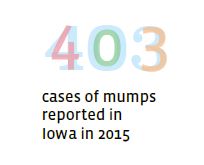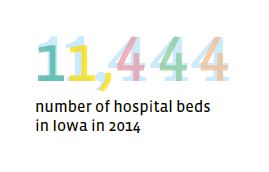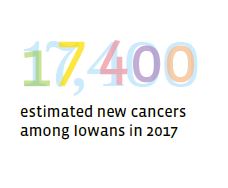This story originally appeared in the spring 2017 issue of InSight.
Breadcrumb
Iowa Health by the Numbers
By Debra Venzke
Published on June 21, 2017
 “Numbers have an important story to tell. They rely on you to give them a voice.”
“Numbers have an important story to tell. They rely on you to give them a voice.”
– Stephen Few, information design educator and author
There’s no shortage of public health challenges to tackle, from long-standing concerns like heart disease and obesity to more recent issues such as opioid addiction and Zika virus.
To make the best choices about where to allocate limited resources, public health practitioners, policymakers, hospital administrators, and other health providers need solid, well-researched information to help guide decisions. Data is not only essential for deciding where to concentrate efforts, but also to inform and advance health policy in the form of regulations, guidelines, and budget priorities.
Many other professionals rely on public health data to support their work: researchers to track health trends, grant writers to complete their applications, community organizers to plan activities, journalists to highlight health issues, and many others.
Several centers based in the College of Public Health produce rich sources of Iowa-specific health data, the collection and storage of which is carefully managed to maintain confidentiality and security. Three online resources of Iowa health data are spotlighted in the following pages.
Iowa Health Fact Book
What percentage of Iowa’s 11th graders smoke cigarettes? How many family practice physicians are there in Sioux County? Is heart disease mortality rising or falling in the state?
The answers to these and a plethora of other public health questions can be found in the Iowa Health Fact Book, a free online resource compiled by the University of Iowa College of Public Health, Iowa Department of Public Health, and other partners.
The Fact Book web site provides information for each of Iowa’s 99 counties and, where possible, includes demographics and vital statistics, data on disease incidence and mortality, health and social determinants of health, health resources, and environmental factors. The information is searchable and available publicly to researchers, public health practitioners, policymakers, and anyone else needing Iowa-specific health facts.
 Previously, the Iowa Health Fact Book had been produced in book form and updated every two years. In its new online form, the information is now updated as new statistics become available and is fully searchable by county or aspects of health, such as cancer, infectious diseases, and health care facilities.
Previously, the Iowa Health Fact Book had been produced in book form and updated every two years. In its new online form, the information is now updated as new statistics become available and is fully searchable by county or aspects of health, such as cancer, infectious diseases, and health care facilities.
“We’re excited about how this new web site will make it easier for users to browse and summarize the data that is specific to their county,” says Jacob Oleson, director of the Center for Public Health Statistics. “Whenever possible, we’ve included the same types of information in the same tabular and graphical format as in the past.”
With ongoing updates, the Fact Book allows for the presentation of data longitudinally, giving a picture of the changing Iowa health landscape, Oleson adds.
“As we continue this effort over the years, we are in a better position to track changes, measure progress, and identify areas of weakness,” Oleson says.
In addition to the UI College of Public Health and Iowa Department of Public Health, contributors to the Iowa Health Fact Book include the Iowa Department of Inspections and Appeals, Iowa Registry for Congenital and Inherited Disorders, Iowa State Trauma Registry, State Health Registry of Iowa/Iowa Cancer Registry, Office of Statewide Clinical Education Programs, Iowa Health Professions Tracking Center, University of Iowa Information Technology Services, Iowa Consortium for Substance Abuse Research and Evaluation, National Center for Health Statistics – U.S. Centers for Disease Control and Prevention, and U.S. Census Bureau.
Burden of Injury in Iowa
 Injuries are a major public health concern that affects all Iowans, regardless of age, race, or gender. However, the distribution of the cause, intent, and type of these injuries varies greatly throughout Iowa’s 99 counties, depending on their population demographics and other factors.
Injuries are a major public health concern that affects all Iowans, regardless of age, race, or gender. However, the distribution of the cause, intent, and type of these injuries varies greatly throughout Iowa’s 99 counties, depending on their population demographics and other factors.
The Burden of Injury in Iowa report, produced as a partnership of the UI Injury Prevention Center (IPRC) and the Iowa Department of Public Health, provides statewide rates of injury deaths and non-fatal hospitalizations for all types of injuries, as well as information on the specific burden of injury in each county of Iowa.
With the most recent data presented in an interactive map, users can click on a county to view its corresponding information. Previous reports are also available in PDF format.
“Injuries are preventable,” says Corinne Peek-Asa, director of the IPRC. “The Burden of Injury in Iowa report has been used extensively by both local health departments and agencies to prioritize injury programs and promote the need for injury prevention throughout the state.”
Efforts to reduce the burden of injuries are most effective when they are tailored to the specific injury burden and the needs of the target population, Peek-Asa adds. She encourages communities, health practitioners, and local policymakers to use the report to develop strategies and policies to reduce injuries.
The report is based on death certificate information from the Iowa Department of Public Health, as well as hospitalization data from the Iowa Hospital Association hospital inpatient discharge data.
State Health Registry of Iowa
In 2017, the State Health Registry of Iowa, also known as the Iowa Cancer Registry, will collect data on an estimated 17,400 new cancers among Iowa residents. Investigators at the Iowa Cancer Registry also estimate that 6,200 Iowans will die from cancer in 2017, 18 times the number caused by auto fatalities.
These estimates are based on mortality data the Iowa Cancer Registry receives from the Iowa Department of Public Health. The registry has been gathering cancer incidence and follow-up data for Iowa since 1973 and is one of fourteen population-based registries and three supplementary registries nationwide providing data to the National Cancer Institute.
Each year, the registry releases the Cancer in Iowa report, which provides county-by-county statistics for new cancer cases and cancer deaths, as well as an estimate of the top 10 types of new cancer and cancer deaths for males and females in Iowa for the coming year. Available online, the 2017 report also includes a special section highlighting liver cancer, which is increasing in Iowa, particularly among the “baby-boomer” population; summaries of current research projects; and a selected list of publications produced during the previous year.
 The registry web site also houses an interactive map that provides cancer incidence rates and cancer morality in Iowa going back to 1973. The data is searchable by county, cancer site, gender, race/ethnicity, and other parameters.
The registry web site also houses an interactive map that provides cancer incidence rates and cancer morality in Iowa going back to 1973. The data is searchable by county, cancer site, gender, race/ethnicity, and other parameters.
“The registry makes this data available so health providers, health departments, and cancer organizations can track progress and determine areas of need,” says Mary Charlton, assistant professor of epidemiology and an investigator with the Iowa Cancer Registry.
In addition to reporting on cancer incidence, survival, and mortality among Iowans, the registry responds to requests from individuals and organizations in the state of Iowa for cancer data and analyses, and provides data and expertise for cancer research activities and educational opportunities.
In 2017, the registry is participating in more than 75 studies, including the Agricultural Health Study, a long-term study of agricultural exposures (including pesticides) and chronic disease—especially cancer—among commercial or private pesticide applicators (and their spouses, if married) in Iowa and North Carolina. Now in its 24th year, the study is funded through the National Cancer Institute and involves several federal agencies.
Registry data are also being used to evaluate the treatment received for a first cancer and the risk it places on the patient for development of a second cancer, to monitor the impact of the Human Papillomavirus Virus (HPV) vaccine on HPV types in cancers, and to research the association between organ transplantation and elevated cancer risks.